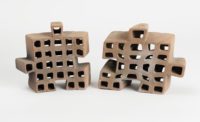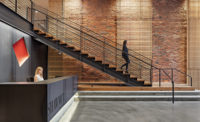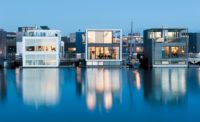In downtown Singapore, where high-rises are built to their lot lines, Oasia, a new 27- story hotel and office building, introduces some leafy green respite from the dense urban setting. Creeping plants of 21 different species climb across the tower’s red mesh facades, hummingbirds and insects feed on nectar, and the petals of spent flowers spin down into the streets below.
New research and industry trends suggest that hotels making room for nature can reap significant advantages. “A hotel’s product is its environment,” says Richard Hassell, a principal at Singapore-based WOHA, architects for Oasia. When biophilic design—design that accounts for humankind’s innate need for connection to nature—adds an extra level of comfort or promotes relaxation, it affects prospective guests’ choices. And when, as in the case of Oasia, the hotel’s facade can also serve as a marketing tool, “it’s an easy sell,” says Hassell. “Hospitality projects are advance soldiers in the fight to have more greenery on buildings.”
The lush expression of Oasia, which opened last April, is not difficult to achieve, especially in tropical Singapore. There have been plants on buildings for centuries, and there’s nothing really innovative about the technology used at Oasia. The hotel’s envelope consists of an outer layer of expanded aluminum mesh, powder-coated in five shades of red, orange, and pink. Behind the mesh, painted precast-concrete panels serve as the weather barrier. Between these two layers, the creepers that climb Oasia’s facades grow in giant fiberglass tubs, with a passageway for maintenance access. There’s some additional expense, but according to WOHA, the cost isn’t prohibitive, and may even be offset by savings elsewhere, on aluminum mesh and painted concrete cladding, for example, the combined cost of which is less than curtain wall.
What is different are the maintenance requirements. “As architects, we’re trained to think that you design a building, it’s made, and then it’s there,” says Hassell. But for a design that integrates living, growing nature to succeed in the long term, there needs to be a champion within the organization operating the building. “It can be more or less labor-intensive, depending how it’s designed,” says Hassell, “but it does require that someone care about it.”
The biophilic design that characterizes Oasia (and WOHA’s work in general) stems from three complementary rationales. The first is stewardship of nature as cities expand: the need to create places for nature at the same time we create floor area. With increasing urbanization, to have any kind of connection to nature, we need to wrap it into our buildings.
The second rationale is “just that selfish delight that comes from living a more beautiful, peaceful, centered, and calm life when you’re surrounded by nature,” says Hassell. A wealth of research from many disciplines demonstrates that this effect is genuine. Since a landmark study in 1984 documented improved recovery rates and reduced requests for pain medication in hospital rooms with a view of nature, hundreds of additional studies have demonstrated the positive impacts of biophilic environments, including reduced stress, improved cognitive performance, and enhanced creativity.
The third rationale is ecosystem services—the multitude of ways natural systems support humankind. Biophilic features can often help with stormwater management, heat island reduction, and pollution mitigation, for example. Specific to the the hospitality sector, a 2014 study from the Cornell School of Hotel Administration (SHA) found that eco-certified hotels recorded higher resource efficiency for both operations and customer activities.
Another 2014 study from the Cornell SHA found that LEED-certified hotels achieved superior financial performance, with higher daily rates, compared to their noncertified competitors, for at least the first two years after certification. Although LEED doesn’t explicitly require the inclusion of biophilic elements, a finding that customers will pay higher rates for a green hotel suggests economic benefits from an approach that integrates nature.
Building on the Cornell financial-performance report, a forthcoming study sponsored by Interface and conducted by Terrapin Bright Green, a New York–based green building research and consulting practice, suggests that biophilia plays a role in customer preferences. Comparing guest comments across a sample of biophilic and conventional hotels, Terrapin’s researchers found the most frequent point of praise from guests who had stayed at a biophilic hotel was its design (whereas praise from guests who had stayed at one of the conventional hotels pertained most frequently to maintenance and service). This matters: according to a recent report from Deloitte, a global financial consultancy, in “the race for guest loyalty,” basics like cleanliness and comfort are no longer enough for hotels to differentiate themselves from their competitors. Millennials, in particular, who will make up three-quarters of frequent business travelers by 2025, are looking for a more memorable experience.
The Park Royal on Pickering, another WOHA-designed building, which has achieved Singapore’s highest environmental certification, provides an example of what the biophilic effect can mean from a marketing perspective. The 300,000-square-feet hotel and office building includes 160,000 square feet of sky gardens, so that an adjacent park appears to be stepping up and through the building. Since the Park Royal on Pickering’s 2013 opening, it has enjoyed close to 100 percent occupancy, room rates double the original projections, and free publicity with its image appearing on travel-related Web pages as an icon of Asia’s hospitality sector. Park Royal has even seen bookings spill over to its other Singapore hotels through their association with it.
Exuberant greenery, although a dramatic expression, is not the only way to achieve biophilic effects. In a previous study, Terrapin identified three categories of biophilic design—nature in the space (the direct, physical presence of nature), natural analogs (nonliving evocations of nature such as organic sequences or shapes in artwork, ornamentation, or furniture), and nature of the space (spatial configurations that resemble conditions found in nature, including those that seem to provide refuge). Together, they comprise 14 types or patterns. To identify the strongest correlations to lowering stress, improving cognitive performance, and elevating emotion and mood, Terrapin cross-checked more than 500 reports and academic publications pertaining to biophilic response, and then ranked the patterns by the strength of research supporting their effects on health and well-being.
In a post-occupancy case study of the Park Royal on Pickering, Terrapin’s researchers found examples of all 14 biophilic patterns, but identified four as predominant. “Visual Connection with Nature” (the extensive greenery, both outside and in) correlates strongly to lowered blood pressure and heart rate, improved mental attentiveness and engagement, and positively affected attitude and overall happiness. “Biomorphic Forms and Patterns” (the abstracted landscape contours of layered precast concrete and interior curvilinear forms in wood) have been identified in some studies as a preferred view. “Risk/Peril” (cantilevered human-scale birdcages, perched at the end of narrow bridges and providing views of the city), when coupled with reliable safeguards, is associated with strong dopamine or pleasure responses. “Complexity and Order,” in which intricate geometric patterns provide rich sensory information adhering to a spatial hierarchy similar to that encountered in nature, appears in the hotel’s interior detailing (examples include a complex wood and metal lattice enclosing a spiral staircase, and wall, ceiling, and partition treatments consisting of thin slats of timber layered in a matrix); the pattern is associated with improved perceptual and physiological stress responses.
Another way of saying all this, of course, is that these patterns make the hotel’s guests feel better. And when guests feel better, they stay longer and come again.
Although “selling beds” is the main source of revenue for hotels, there are others: “It used to be that the hotel lobby was the living room of a community,” says Bill Browning, a partner at Terrapin. “Many of the brands are now rediscovering that lobbies can be fantastic social spaces and sources of additional revenue.” To investigate the role of biophilic design in that trend, Terrapin’s researchers monitored occupancy patterns in the lobbies of six Manhattan hotels, three of which had biophilic features. In the nonbiophilic lobbies, about 25 percent of users were making extended use of the lobby—buying food or drink, meeting people, working, or relaxing. In the biophilic lobbies, the proportion of extended users rose to 36 percent. In one of the biophilic hotels—one that had been designed deliberately to encourage extended lobby activities—they found that its users also included residents from the surrounding neighborhood. This provided additional revenue without the need to sell another bed.
One of the hotel brands in the lobby study, Starwood Capital Group’s 1 Hotel, has put biophilic design at the center of its identity. The hotel’s first ground-up new building, 1 Hotel Brooklyn Bridge, designed by Marvel Architects, with interior architecture by Incorporated, is scheduled to open in February 2017 at the edge of the East River across from Lower Manhattan.
The architecture of the 194-key-hotel/106-unit-condominium building makes these connections literally and figuratively. Extensive greenery on roofs and terraces integrates the building with Brooklyn Bridge Park. The terraces, together with building-height vertical fins, evoke eroded geological formations, a reference to the bluffs in this part of Brooklyn.
The architects use this concept to make a transition between the park in front and the established neighborhood close behind. “The idea was that the building would become embedded on the neighborhood side, and riff off the bluffs on the river side,” says Dennis Vermeulen, a director at New York–based Marvel. Connecting the neighborhood and park, four public passageways cut through the building. Always open, these portals include boulders, trees, plantings, and art, and are lined with yellow pine recycled from the warehouses that used to occupy the site. In creating these transition areas from the buzz of the city to the calm of the park, says Vermeulen, the architects wanted the public to feel that the building is part of the park, and part of their experience.
The interior architecture continues the use of biophilic elements to connect guests to nature, and also to Brooklyn. “In the world of hospitality now, there’s an anticorporate, anti-brand approach to developing spaces,” says Adam Rolston, a partner at Incorporated, also based in New York. “People want an authentic experience that connects them to the place culturally, visually, and physically.”
One of the project’s primary interior design strategies is to use natural and highly tactile materials that are relevant to the locale, as well as those that reference natural processes. Drawing inspiration from the history of Brooklyn’s waterfront, the project uses salvaged and weathered woods throughout—as a ceiling treatment evocative of the former warehouses, as a lining for elevator cabs, and as millwork in guest rooms. Board-formed concrete complements the wood. Stone for a massive white granite stair in the lobby comes from the same quarry as the Brooklyn Bridge. Carpet patterns throughout the hotel are generated from photographic images of rusted-steel ship hulls and digitally printed onto the carpet. “Almost every material had to have some effect of weathering, oxidation, or being somehow wrought,” says Rolston. To elaborate the material connection to nature and place, Incorporated collaborated with local fabricators, inviting them to suggest materials and methods and allowing these suggestions to influence the development of the hotel’s aesthetic.
Starwood Capital had experience with incorporating natural materials into 1 Hotel’s two other locations. Waad El Hadidy, a designer with the company, predicts people will connect with the highly textured and narratively rich finishes of the 1 Hotel Brooklyn Bridge. “We get asked all the time, ‘What does this come from?’” she says. “Not only guests, but hotel staff too are genuinely interested. People are drawn to touch things that have a story.”
|
Continuing Education

To earn one AIA learning unit (LU), including one hour of health, safety, and welfare (HSW) credit, read “Suite Life,” review the supplemental material listed below, and complete the online test. Upon passing the test, you will receive a certificate of completion, and your credit will be automatically reported to the AIA. Additional information regarding credit-reporting and continuing-education requirements can be found online at continuingeducation.bnpmedia.com.
Supplemental Material 14 Patterns of Biophilic Design: Improving Health and Well-Being in the Built Environment (Introduction through Chapter 2) Terrapin Bright Green
Learning Objectives 1 Outline the ecosystem services that biophilic elements can provide. 2 Describe some of the impacts that biophilic elements can have on the health and well-being of building occupants. 3 Identify the approaches to biophilia that are most appropriate to the hospitality sector. 4 Describe how biophilia was incorporated into the Park Royal on Pickering and the Oasia, both in Singapore, and the 1 Hotel Brooklyn Bridge, in New York.
AIA/CES Course #K1612A
For CEU credit, read "Suite Life" and take the quiz at continuingeducation.bnpmedia.com, or use our architectural record continuing-education app, available in the itunes store. structure, finishes, and other original fabric when
a building is moved.
significant buildings.
|












Post a comment to this article
Report Abusive Comment